Ford B-Series
- For the Mazda vehicle that is a derivative of another Ford vehicle, see Mazda B-series.
| Ford B-Series | |
|---|---|
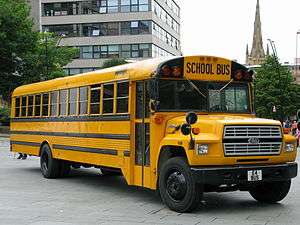 | |
| Overview | |
| Manufacturer | Ford |
| Also called | Mercury MB-Series (1948–1968) |
| Production | 1948–1998 |
| Body and chassis | |
| Class | Type C (conventional) |
| Layout | 4x2 |
| Body style(s) |
Cowled chassis
|
| Related | Ford F-Series (medium-duty trucks) |
| Powertrain | |
| Engine(s) |
Gasoline Diesel |
| Transmission(s) |
Manual Automatic |
| Chronology | |
| Predecessor | 1941 Ford truck chassis |
| Successor | none |
The Ford B-Series is a bus chassis that was manufactured by Ford Motor Company from 1948 to 1998. Derived from the medium-duty variants of the Ford F-Series, the B-Series were produced as a cowled chassis; the design was a bare chassis aft of the firewall. While primarily used for school bus applications in the United States and Canada, the chassis was exported worldwide for to construct a wide variety of bus bodies.
Prior to 1969, Lincoln-Mercury dealers in Canada marketed the B-Series as part of the Mercury M-Series truck line. At the time, rural communities in Canada were serviced by either the Ford or the Lincoln-Mercury dealer network, but not both networks concurrently.
As part of the late 1996 sale of the Louisville/AeroMax heavy-truck line to Freightliner, the medium-duty F-Series and B-Series were phased out of production following the 1998 model year. While Ford would re-enter the medium-duty segment with the F-650/F-750 Super Duty for 2000, as of 2016, it has not produced another cowled bus chassis. Currently, Ford bus production is concentrated on cutaway chassis vehicles. In the cowled-chassis segment, the role and market share of the Ford B-Series was largely superseded by the Freightliner FS-65, introduced in late 1997.
Design History
The B-Series was introduced in 1948 as the school bus variants of the Ford F-5 and F-6 (1 ½ and 2-ton) medium-duty conventionals. In 1953, the F-Series and B-Series adopted the 3-digit model nomenclature still in use today and the B-Series effectively became the B-600, B-700, and B-800 models. Diesels were badged similarly with an extra "0" at the end of the model notation. From beginning to end the B-Series paralleled the Medium Duty F-Series in its development. Both F and B Series were identical to their light duty brothers in appearance until 1967 when they received a front end design of their own. This trend continued until discontinuation in 1998.
1948-1952
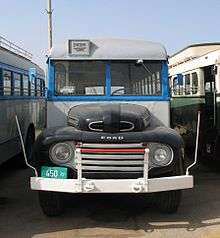
The B-Series made its debut in 1948 along with Fords first post war design of their newly named F-Series trucks. The new design implemented a flat, single piece winshield and headlights that were integrated into the front fenders giving them a more modern look. The front fenders were squared off at the fascia that touted a new, horizontal bar grille. The dash was redesigned but still had a very plain, utilitarian look. The trucks remained much the same until 1951 when a new, single bar horizontal grille was fitted to the front along with different hood trim.
- Engines
1953-1956
In 1953, Ford celebrated their 50th anniversary and the B-Series saw a redesign with new B-"00" designations added to the name. The redesign implemented a set back front axle that made the front look nose heavy, but allowed for a tighter turning radius. The hood was also longer and flowed into the fenders. The grille was still horizontal, but was two bars as opposed to the one large one in the previous model. 1954 buses received a refreshed grille and a new OHV V8 engine option to replace the old 239 Flathead V8. The 1956 buses got a new wraparound windshield and restyled dashboards as well as a new grille that was similar to the 1953 model year.
- Engines
- 215 cu in (3.5 L) OHV I6 (1953)
- 239 cu in (3.9 L) Flathead V8 (1953)
- 223 cu in (3.7 L) OHV "Mileage Maker" I6 (1954–1956)
- 239 cu in (3.9 L) Ford Y-Block OHV V8 (1954–1955)
- 272 cu in (4.5 L) Ford Y-Block OHV V8(1956)
1957-1960
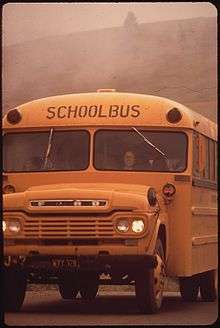
In 1957 the B-Series got a redesigned front end and a new dash area. The front hood was now flush with the fenders creating a more boxy look. The 1958 models saw a new grille and quad headlamps along with new circular gages.
- Engines
- 223 cu in (3.7 L) Ford "Mileage Maker" I6 (1958–1960)
- 272 cu in (4.5 L) Ford Y-Block V8 (1957)
- 292 cu in (4.8 L) Ford Y-Block V8 (1958–1960)
- 302 cu in (4.9 L) Lincoln Y-block V8[1]
1961-1966

The B-Series was redesigned for 1961 offering a new horizontal grille and fenders that were flared just above the front wheel to allow for larger wheels. The new chassis and front fascia made the truck look lower and wider than previous years. The quad head lamps were replaced with single lights integrated into the grille. The frame and suspension were also redesigned to be tougher than before. This generation of B-Series would be the last to utilize the same front fascia as light duty Ford trucks. Both the B-Series and medium duty F-Series were to gain their own look.
- Engines
- 262 cu in (4.3 L) Ford I6 (1961–1964)
- 292 cu in (4.8 L) Ford Y-Block V8 (1961–1963)
- 330 cu in (5.4 L) Ford FT V8 (1964–1966)
- 361 cu in (5.9 L) Ford FT V8 (1964–1966)
- 391 cu in (6.4 L) Ford FT V8 (1964–1966)
- 240 cu in (3.9 L) Ford 240 I6 (1965–1966)
- 300 cu in (4.9 L) Ford 300 I6 (1965–1966)
1967-1979
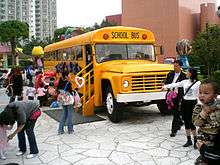
Ford completely redesigned both the B-Series and medium-duty F-Series and departed from using the same grilles as the lighter duty F-Series trucks. The new buses were taller and wider with a large grille utilizing much of the space of the front fascia. The new grille was rectangular with the single headlights being placed very near the far ends of the grille. The fenders were even more flared than before to allow for a wider track and larger wheels and tires needed to make the necessary gain in GVW to remain competitive. This generation was also the first to receive the option of a diesel engine in place of the strictly gasoline lineup in the past. An extra "0" was added to the series notation on diesel models. After 1968, the Mercury-branded version of the B-Series was discontinued in the Canadian market. For 1973, the grille was updated with longer teardrops around the headlights and F O R D block lettering appeared on the front of the hood just above the grille.
- Engines
- Gasoline
- 330 cu in (5.4 L) Ford FT V8 (1967–1977)
- 361 cu in (5.9 L) Ford FT V8 (1967–1977)
- 391 cu in (6.4 L) Ford FT V8 (1967–1977)
- 370 cu in (6.1 L) 385 V8 (1978–1979)
- Diesel
- Caterpillar 1140 V8 (1968–1974) B-6000 Only
- Caterpillar 1145 V8 (1968–1974) B-6000 and B-7000
- Caterpillar 3208 V8 (1975–1978) B-7000 Only
1980-1994
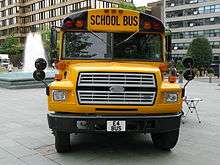
In 1980, Ford redesigned the F-Series medium-duty trucks and B-Series to look more like their heavy duty siblings. They were an all new design implementing styling cues from the Louisville line of trucks. Although the medium duty F-Series had the revised interior from the lighter duty trucks, the B-Series carried over the dashboard from the previous generation. To complement the new design there was a new set of gasoline and diesel engines that became available starting in 1980 and more in 1983. In 1985, Ford took out the "F-O-R-D" lettering in the center of the grille and replaced it with a larger version of the blue-oval logo being phased in on most Ford vehicles starting in 1982. For the most part during the 1980s the B-Series saw minimal changes in design. This version of the B-Series is available with two different hood designs: a rear-hinged hood and a tilt-forward hood. During the mid-1980s, the rear-hinged hood was discontinued as the tilt-forward hood improved engine access and it was a design that had been adopted by Ford's competitors.
- Engines
- Gasoline
- 370 cu in (6.1 L) Ford 385 V8 Engine (1980–1991)
- 429 cu in (7.0 L) Ford 385 V8 Engine (1982–1994)
- Diesel
- 8.2 L Detroit Diesel "Fuel Pincher" V8 (1980–1990)
- 6.6 L and 7.8 L Ford-New Holland I6 (1985–1991)
- 5.9 L Cummins 5.9 6BT I6 (1992–1994)
- 10.4 L Caterpillar "3208" V8 (1983-1990)
1994-1998
In 1994, Ford updated the hood on the medium-duty F-Series to a more aerodynamic design. For the B-Series swan song, the chassis stayed the same but the new aerodynamic cowl was applied. Inside, the 1980s instrument panel and steering column were retained, although a tilt steering wheel became an option. Buses with this option are distinguished by their Navistar-sourced steering wheels. This generation became the first of the B-Series to be powered exclusively by diesel engines; their increasing popularity in conventional school buses led to their standardization in 1990, following suit with International (Navistar).
By the end of the 1990s, the number of major school bus manufacturers had dwindled from five to three; faced with potential closure, the remaining manufacturers entered into business agreements with chassis suppliers. This made it increasingly difficult for Ford to find buyers for the B-Series chassis. This prompted Ford to take a serious look at a possible elimination of the B-Series platform or the purchase of their own body manufacturer to guarantee a demand. The answer came as a bombshell in 1998 with the sale of the heavy-duty "Louisville" truck division to Freightliner, less than a year after the line had been completely redesigned; the final result was the now-defunct Sterling brand of trucks. A condition of the sale required an absence of Ford from competing directly against Freightliner for ten years after the contract was signed. As a result, after 50 years, the production run of the B-Series came to an end.
- Engines
- Gasoline
- 429 cu in (7.0 L) Ford 385 V8 Engine (1994–1998)
- Diesel
- 7.2 L Caterpillar 3126 I6 diesel (1994–1998)
- 5.9 L Cummins 5.9 6BT/ISB I6 diesel (1994–1998)
Discontinuation
After a 50-year production run, the 1998 model year marked the end of the Ford B-Series. At the time, Ford Motor Company decided to end production of cowled school bus chassis for several reasons. Alongside the B-Series, the medium-duty F-Series was discontinued and replaced by a new model developed in a joint venture with Navistar International; this became the 2000-2015 F-650/F-750 Super Duty. As part of the late 1996 sale of the Class 8 truck line to the Freightliner subsidiary of Daimler-Benz, a 10-year non-compete agreement stipulated the two companies would not introduce products in direct competition with one another; Ford would be unable to market a replacement for the B-Series as it would be in competition with the newly developed Freightliner FS-65 (until 2007 at the earliest). Although developed entirely separate from the sale of the Ford truck line (which created the Sterling brand), the FS-65 would inherit much of the cowled-chassis market share vacated by the B-Series.
Aside from the sale to Freightliner, the discontinuation of the B-Series was also heavily influenced by factors affecting school bus body manufacturers. During the 1990s, the practice of customers choosing cowled chassis separate from the body manufacturer began to fade as body manufacturers, in order to stay competitive, entered into supply agreements or were purchased outright by chassis suppliers. In 1992, General Motors and Blue Bird Corporation entered into a 10-year contract to supply the B7 chassis exclusively; other chassis became an extra-cost option. AmTran and Thomas Built Buses were purchased outright in 1995 and 1998 by truck manufacturers Navistar and Freightliner, respectively. As the GM/Blue Bird contract expired in 2003, Ford sought a supply agreement with the company, leading to a few prototypes based on the all-new F-650 Super Duty; it did not lead to a production vehicle. As a result, Blue Bird designed the Type C Vision chassis in-house and once again Ford was left without potential customers for any chassis orders after the non-compete agreement had expired.
As of the 2015 model year, Ford no longer produces a cowled-chassis bus in North America. Currently, all Ford buses are based on cutaway vehicles, using the E-Series, F-450/F-550 Super Duty, and F-650 Super Duty. Ford bus chassis are used not only for school buses, but also for shuttle buses, paratransit, and various other commercial uses.
Body Manufacturers
The B-Series was widely available and was used by many manufacturers throughout its production run.
| Body Manufacturer | Model Name | Years Available | Notes |
|---|---|---|---|
| American Transportation Corporation | Volunteer (1992–1996) CS (1997–1998) |
1992–1998 | Ford was the only non-International chassis to be bodied by AmTran |
| Blue Bird Corporation | Conventional | to 1998 | |
| Carpenter Crown By Carpenter |
Classic | to 1998 | From 1996 to 1999, Carpenter used the Crown by Carpenter brand name on their buses. |
| Les Enterprises Michel Corbeil | 1990–1998 | Sold only in Canada. | |
| Superior Coach Company | Pioneer | to 1982 | |
| Perley A. Thomas Car Works Thomas Built Buses, Inc. |
Saf-T-Liner Conventional | 1972–1998 | replaced by Freightliner-based buses (FS-65) |
| Ward Body Works | Master Deluxe Volunteer |
to 1992 | |
| Wayne Corporation Wayne Wheeled Vehicles |
Lifeguard | 1973–1995 |
References
The Auto Editors of Consumer Guide Ford Truck Chronicle Lincolnwood, Illinois: Publications International. 2006.
- ↑ "1957 Ford Trucks Brochure". oldcarbrochures.com. Retrieved 2012-01-16.
See also
| Wikimedia Commons has media related to Ford B-Series. |
| « previous— Ford Motor Company heavy truck timeline, North American market, 1980–present | ||||||||||||||||||||||||||||||||||||||
|---|---|---|---|---|---|---|---|---|---|---|---|---|---|---|---|---|---|---|---|---|---|---|---|---|---|---|---|---|---|---|---|---|---|---|---|---|---|---|
| Type | 1980s | 1990s | 2000s | 2010s | ||||||||||||||||||||||||||||||||||
| 0 | 1 | 2 | 3 | 4 | 5 | 6 | 7 | 8 | 9 | 0 | 1 | 2 | 3 | 4 | 5 | 6 | 7 | 8 | 9 | 0 | 1 | 2 | 3 | 4 | 5 | 6 | 7 | 8 | 9 | 0 | 1 | 2 | 3 | 4 | 5 | 6 | ||
| Medium-Duty | F-Series (F-600/700/800/8000) | F-Series | F-Series Super Duty (F-650/750) | Super Duty | ||||||||||||||||||||||||||||||||||
| Conventional | L-Series/"Louisville" | Louisville | ||||||||||||||||||||||||||||||||||||
| LTL-9000 | ||||||||||||||||||||||||||||||||||||||
| Aeromax | Aeromax | |||||||||||||||||||||||||||||||||||||
| Cabover (COE) | C-Series | |||||||||||||||||||||||||||||||||||||
| Cargo | LCF | |||||||||||||||||||||||||||||||||||||
| CLT-9000 | ||||||||||||||||||||||||||||||||||||||
| Bus | B-Series (B600/B700/B800/B8000) | B-Series | ||||||||||||||||||||||||||||||||||||